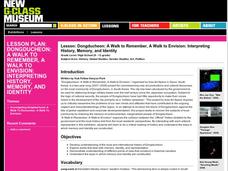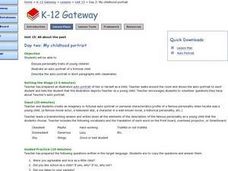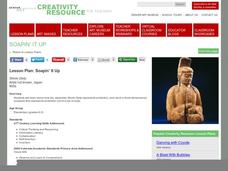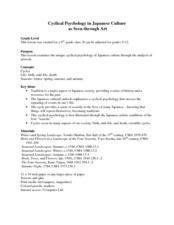Curated OER
Asian Art
Art from early China, Korea, and Japan is historically significant. Present these stunning images to your class, while you explain art movements that define traditional Chinese, Korean, and Japanese time periods and culture. Note: This...
Curated OER
Lesson: A Picture is Worth a Thousand Words: Attention to Detail
After a quick warm up activity, learners get ready to use their keen observation skills to examine an ornate Japanese pencil box. They discuss the artistry, skills, and story of the box, paying close attention to details. They then...
NPR
Civil Rights of Japanese-American Internees
Prompted by a viewing of Emiko and Chizu Omori’s Rabbit in the Moon, a documentary about the internment of Japanese-Americans during World War II, high schoolers examine a series of documents, including the Bill of Rights and the UN’s...
Curated OER
Lesson: Dongducheon: A Walk to Remember, A Walk to Envision: Interpreting History, Memory, and Identity
Cultural discourse can start through a variety of venues. Learners begin to think about how our minds, memories, and identities shape our attitudes toward culture and history. They analyze seven pieces from the Dongducheon art exhibit...
Curated OER
My Childhood Portrait
Students practice descriptive writing by viewing auto-portraits of young children. In this art analysis lesson, students examine an auto-portrait of their teacher as a young child and ask him/her questions about their youth. Students...
Curated OER
Feudal Powers in Japan
A traditional textbook chapter focuses on feudal powers in Japan, and includes vocabulary, note-taking tips in the sidebar, main ideas, and follow-up assessment questions. It also incorporates opportunities for art analysis and geography...
Curated OER
Lesson: Soapin' It Up
A Japanese Shinto deity from the early 900s inspires youngsters to think symbolically. They analyze the carved sculpture, the techniques used to create it, and its cultural or symbolic meaning. Then, they design and carve a symbolic...
Stanford University
Japan and America
When Commodore Matthew Perry sailed to Japan and demonstrated American naval strength, he forced the empire to engage in trade with the United States. How did this new, strong-armed relationship influence both parties? Pupils consider...
Curated OER
Japanese-American Internment: The Art of Gaman
Students explore Japanese-American internment. For this World War II lesson, students view a PowerPoint lecture that features the art of Gaman and determine what the art reveals about the experiences of the interned Japanese-Americans.
Curated OER
Letters from the Japanese American Internment
Students delve into primary research. In this Japanese Internment lesson plan, students make deductions about life in an internment camp by reading and comparing letters written to Clara Breed. Along the way, they consider the advantages...
Curated OER
Japanese Poetry: Tanka? You're Welcome!
Students analyze Japanese tanka poetry. In this Japanese poetry lesson, students identify analyze the structure of tanka poetry. Students complete the activities at the given links for the lesson and compose two tanka poems.
Curated OER
Dorothea Lange and the Relocation of Japaneses Americans
Young scholars analyze Dorothea Lange's photographs about Japanese American relocation. In this art and history lesson, students analyze a photograph about the relocation of Japanese Americans. Young scholars discuss the impact of...
Indiana University
British Literature Restoration Unit: The Pillow Book – Sei Shonagon
First drafted in the year 996, The Pillow Book contains reflections of those met by a lady-in-waiting in the Japanese court. A brief summary, historical context, and discussion questions are provided on the first two pages. Then, two...
National Endowment for the Humanities
Hamlet and the Elizabethan Revenge Ethic in Text and Film
Young scholars research the social context of Elizabethan England for Shakespeare's "Hamlet". They identify cultural influences on the play focusing on the theme of revenge and then analyze and compare film interpretations of the play.
Curated OER
The Japanese Kite Stories
Third graders recognize the importance of making and flying of kites in the Japanese culture. They make up a story about themselves, their families, or just a story that was written by a third grade Japanese student when creating their...
Curated OER
Cyclical Psychology in Japanese Culture
Students create artistic representations of various cyclical patterns after analyzing the importance of cyclical psychology in Japanese culture. This lesson can be done in an Art class or as part of a unit in a History or Language Arts...
Curated OER
What's In a Name?
Students explore the relationship between names and certain cultures and locations. In this identity lesson, students create family migration or immigration maps. Students read excerpts from When My Name was Keoko and Lost Names: Scenes...
Curated OER
Life in the Floating World: Ukiyo-e Prints and the Rise of the Merchant Class in Edo Period Japan
Students explore Jananese history through the use of the woodblock print called "ukiyo-e" prints. The audience attracted to the prints, their interests and tastes as well as how the prints reflected the life of the merchant class is the...
Curated OER
Taoism
Pupils identify and interpret Taoism. Students gain knowledge of various eastern philosophies. Pupils transfer knowledge gained using the higher order thinking skills for analysis. Students identify the key figure in Taoism. Pupils...
Curated OER
"Aerogrammes"
Learners examine Asian American culture through the analysis of the poem, 'Aerogrammes.' They watch a video, read and discuss the poem, take a field trip to Chinatown, and write a poem about their Chinatown experience.
Curated OER
Papel Picado ( Mexican Cut Paper)
Fifth graders describe the characteristics of a piece of "papel picado", or Mexican cut paper, which is seen in the Dia de los Muertos festival. They predict what medium was used in the papel picado art. They explain how the scene in the...
Curated OER
Flawed Democracies, Human Rights
Students investigate the bombing of Pearl Harbor. In this U.S. History lesson, students discover the Japanese internment camps and why our government chose to relocate the Japanese. Students examine photographs from the era and their...
Curated OER
Shinto, Japan's First Religion
Students participate in centers activities that enrich understanding of Japanese culture, history, geography, art, and religion.
Curated OER
1,000 Cranes with a Pal
Students write a letter to a pen pal about the book they read 1,000 Cranes in Hiroshima. In this writing lesson plan, students write about the conflicts and events that occurred in the book.

























